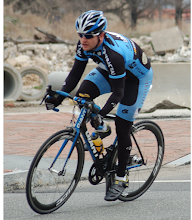 Today was Lactate Threshold Test day.
Today was Lactate Threshold Test day.I met with Joe Wentzell at Breakaway Bikes at 10:00 AM for the test.
It was fun being back in the shop. I used to do their weekend RPM classes all the time. The classes I did were, in essence, structured group rides on a large clusters of Computrainers. They offer classes with more individualized programs during the week, but I had a harder time fitting them into my schedule. It's an awesome way for new cyclists to get into the sport or to stay fit in the winter without riding in the cold. They've made a number of improvements since I'd been there last. There's now an alcove to peel off outer layers and change your shoes, plus a set of cubes to keep all your stuff in.
The test itself looks for when lactic acid begins to accumulate in my bloodstream. When I cross 5.0 mmol, that's my threshold. We're also looking for other more subtle data, like how my heart rate reacts to increased exertion.
The test isn't all that bad. Joe set me up at 150 watts to start and would increase the resistance ever four minutes. Just before he increased the resistance, he would take a small blood sample from my finger (using something like the diabetic finger-stick pins) and put it in a scanner that showed my current level of lactic acid accumulation. It's not a maximal test, so the intensity never really gets that hard (if you're used to threshold work, anyway).
After I had obviously gone past threshold (not just from the lactic analyzer, you could almost see the deflection point in my heart rate and hear it in my breathing), Joe had me cool down while he started entering data in the computer. It's kind of neat cooling down while plugged into a computerized ergometer, since you can see your heart rate and power drift down.
 Joe plugged in the data and showed me some interesting results. I had estimated my threshold to be 160 BPM and 232 watts. I was close on the heart rate, but WAY off on the power.
Joe plugged in the data and showed me some interesting results. I had estimated my threshold to be 160 BPM and 232 watts. I was close on the heart rate, but WAY off on the power.Joe showed me the graph and the data that my threshold was 157 BPM and 192 watts. It's 40 watts lower than I had expected.
I was stunned. In a couple exertion tests on the Computrainer, I turned in power number that should have put my power at threshold higher. But the blood test doesn't lie.
Joe explained that as someone who was coming back after a long training gap, my muscles remembered how to do this and could push pretty hard. He had not doubt that I could do a 20-minute time trial test at 230 watts or well above. The problem is that the cardiovascular system doesn't run off muscle memory. It runs off a bunch of processes at the cellular level, and it had lost a lot of development in the last two years. Basically, my muscles were fit and ready to go, but my heart and lungs didn't have the capacity to provide them with the resources they needed to go all out. That explained why I was seeing such high numbers in the gym (like a recent day where I did 6 reps each of 720 pounds on the leg press and 275 pounds on the squat) but had such a low threshold power.
If I had kept training at the power levels I saw in my exertion tests, I'd be pushing too hard. Like so many other athletes, I was training too hard for my own good and didn't even know it. Aerobic development is a strange thing. It actually gets better at lower intensities than it does at higher ones. I would have been training for speed and power without having the endurance to back them up. I'd be like a strong sprinter who can't keep up with the pack long enough to outsprint them.
So what does this mean for my training? If I were training just off heart rate, it probably would't mean much. Since I'm training with power, though, it means my training power levels will be a good bit lower than I had anticipated.
This will mean a few changes in my training plan. I'll be repeating my last 4 weeks of training on the bike with the new power levels. Looking ahead at my schedule, it probably means that instead of sprint & power training in September, I'll be just starting to do long Threshold work.
I highly recommend this kind of testing for athletes. It's so easy to incorrectly estimate your own performance. We all want to be better than we are and to train as hard as our bodies will tolerate. A test like this gives you some cold hard facts about where you are and how you might improve.
